Cardamom, often called the “Queen of Spices,” is a highly valued spice used in cooking, baking, and traditional medicine worldwide. Native to the Indian subcontinent, it thrives in tropical and subtropical climates. Growing cardamom at home can be a rewarding experience, allowing you to harvest fresh, aromatic pods. Here’s a comprehensive guide to help you grow cardamom from seed and care for your plant.
1. Getting Started with Cardamom Seeds
Choose Fresh Seeds: For the best results, start with fresh, viable cardamom seeds. Avoid seeds that show signs of mold, damage, or dryness. Plump, healthy seeds are crucial for successful germination.
Soak the Seeds: Before planting, soak the seeds in warm water for 12 hours. This helps soften the seed coat and enhances the germination process.
2. Planting Cardamom Seeds
Prepare the Soil: Cardamom thrives in rich, loamy soil with excellent drainage. You can create the ideal soil mix by combining compost, sandy soil, and a small amount of perlite or vermiculite. This ensures the roots have proper aeration and nutrients.
Planting Depth: Sow the seeds about 1 inch deep in the soil. Plant them in individual pots or directly in the garden.
Spacing: Since cardamom plants can grow quite large, space the seeds or seedlings at least 2 feet apart. This gives them room to spread and develop properly.
Watering: After planting, water the seeds gently but thoroughly. Keep the soil moist but not waterlogged, as cardamom is sensitive to overwatering.

3. Growing Conditions for Cardamom
Light: Cardamom plants prefer indirect sunlight or partial shade. In their native habitat, they grow under the shade of taller trees, so try to mimic this environment by placing them where they won’t receive harsh direct sunlight.
Temperature: Ideal temperatures for cardamom range between 22°C to 32°C (72°F to 90°F). Cardamom plants are sensitive to cold, so avoid exposing them to temperatures below 18°C (64°F).
Humidity: These plants thrive in humid conditions. Ensure the soil remains consistently moist, but avoid overwatering. You can increase humidity around the plant by misting the leaves regularly or placing a humidifier nearby.
Fertilization: During the growing season, feed your cardamom plant with a balanced, water-soluble fertilizer every three weeks. This supports healthy growth and pod production.
4. Caring for Green Cardamom
Pruning: As the plant matures, it may send out shoots. Prune any weak or unhealthy shoots to direct the plant’s energy into stronger growth.
Pest Control: Be on the lookout for pests like aphids, spider mites, and mealybugs. Using organic solutions like neem oil can help keep these pests under control without harming the plant.
Harvesting: Cardamom pods are ready to be harvested when they turn from green to a yellowish-green hue. It’s crucial to pick the pods before they split open to preserve the flavor and aroma. Harvesting early ensures the best quality of the spice.
5. Additional Tips for Growing Cardamom
Repotting: If you are growing cardamom in a container, you may need to repot it once it outgrows its pot. Choose a slightly larger container to allow room for continued root growth.
Mulching: Apply a layer of organic mulch around the base of the plant. This helps retain moisture in the soil, suppresses weed growth, and keeps the roots cool.
Patience is Essential: Growing cardamom takes time, and it may be a few years before you see flowers and pods. Be patient—good things come to those who wait!
Conclusion
Growing cardamom from seed is a slow process, but the effort is well worth it. With the right conditions and care, you’ll eventually be able to enjoy the rich, fragrant taste of home-grown cardamom in your cooking and beverages. Whether you are cultivating a small indoor garden or a larger outdoor plot, cardamom is a unique and rewarding plant to grow.
